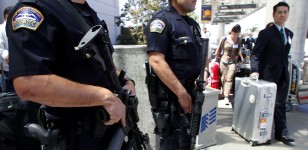Editorial Note – In 1878, the Posse Comitatus Act gained the force of law and by subsequent acts of Congress prohibits the armed forces of the United States to be directed to enforce civilian law within the United States and its territories. This came in response to the Compromise of 1877 over the election of President Rutherford B. Hayes (Who actually had less Electoral votes) to end the Reconstruction Period in the southern states after the Civil War. However, despite the prohibition to use military assets and personnel in law enforcement, our civilian law enforcement are increasingly employing military tactics and technology.
Different times call for different tactics, but a lot of Americans are becoming increasingly alarmed over the transformation of many large and small police and sheriff’s departments in the use of new tactics and resources. In the wake of the infamous North Hollywood bank robbery shootout of 1997, where the police were out gunned by two men wearing extensive body armor, the constant threat of terror, Mexican drug cartels cross-border incursions, and the rise of Gangs acquiring similar weapons, it is understandable that police must ‘armor up.’
You be the judge, is law enforcement now a military unit? Have they crossed that imaginary line, or are many folks just afraid that government in general is getting way too strong, way too invasive, and way too militant?
How the War on Terror Has Militarized the Police
By ARTHUR RIZER & JOSEPH HARTMAN – Arthur Rizer, a former Washington state peace officer who earned a Bronze Star and Purple Heart while serving with the U.S. Army in Iraq, currently works at the U.S. Department of Justice. (The views expressed by Mr. Rizer are entirely his own, and he does not speak for the Department of Justice.) Joseph Hartman, a Ph.D. candidate in government at Georgetown University, practices law in Arlington, Virginia.
Over the past 10 years, law enforcement officials have begun to look and act more and more like soldiers. Here’s why we should be alarmed.
At around 9:00 a.m. on May 5, 2011, officers with the Pima County, Arizona, Sheriff’s Department’s Special Weapons and Tactics (S.W.A.T.) team surrounded the home of 26-year-old José Guerena, a former U.S. Marine and veteran of two tours of duty in Iraq, to serve a search warrant for narcotics. As the officers approached, Guerena lay sleeping in his bedroom after working the graveyard shift at a local mine. When his wife Vanessa woke him up, screaming that she had seen a man outside the window pointing a gun at her, Guerena grabbed his AR-15 rifle, instructed Vanessa to hide in the closet with their four-year old son, and left the bedroom to investigate.

Los Angeles Airport Police officers stand in front of the Tom Bradley International Terminal at LAX airport in Los Angeles May 2, 2011.
Within moments, and without Guerena firing a shot–or even switching his rifle off of “safety”–he lay dying, his body riddled with 60 bullets. A subsequent investigation revealed that the initial shot that prompted the S.W.A.T. team barrage came from a S.W.A.T. team gun, not Guerena’s. Guerena, reports later revealed, had no criminal record, and no narcotics were found at his home.
Sadly, the Guerenas are not alone; in recent years we have witnessed a proliferation in incidents of excessive, military-style force by police S.W.A.T. teams, which often make national headlines due to their sheer brutality. Why has it become routine for police departments to deploy black-garbed, body-armored S.W.A.T. teams for routine domestic police work? The answer to this question requires a closer examination of post-9/11 U.S. foreign policy and the War on Terror.
Ever since September 14, 2001, when President Bush declared war on terrorism, there has been a crucial, yet often unrecognized, shift in United States policy. Before 9/11, law enforcement possessed the primary responsibility for combating terrorism in the United States. Today, the military is at the tip of the anti-terrorism spear. This shift appears to be permanent: in 2006, the White House’s National Strategy for Combating Terrorism confidently announced that the United States had “broken old orthodoxies that once confined our counterterrorism efforts primarily to the criminal justice domain.”
In an effort to remedy their relative inadequacy in dealing with terrorism on U.S. soil, police forces throughout the country have purchased military equipment, adopted military training, and sought to inculcate a “soldier’s mentality” among their ranks. Though the reasons for this increasing militarization of American police forces seem obvious, the dangerous side effects are somewhat less apparent.
Undoubtedly, American police departments have substantially increased their use of military-grade equipment and weaponry to perform their counterterrorism duties, adopting everything from body armor to, in some cases, attack helicopters. The logic behind this is understandable. If superior, military-grade equipment helps the police catch more criminals and avert, or at least reduce, the threat of a domestic terror attack, then we ought deem it an instance of positive sharing of technology — right? Not necessarily. Indeed, experts in the legal community have raised serious concerns that allowing civilian law enforcement to use military technology runs the risk of blurring the distinction between soldiers and peace officers.
This is especially true in cases where, much to the chagrin of civil liberty advocates, police departments have employed their newly acquired military weaponry not only to combat terrorism but also for everyday patrolling. Before 9/11, the usual heavy weaponry available to a small-town police officer consisted of a standard pump-action shot gun, perhaps a high power rifle, and possibly a surplus M-16, which would usually have been kept in the trunk of the supervising officer’s vehicle. Now, police officers routinely walk the beat armed with assault rifles and garbed in black full-battle uniforms. When one of us, Arthur Rizer, returned from active duty in Iraq, he saw a police officer at the Minneapolis airport armed with a M4 carbine assault rifle — the very same rifle Arthur carried during his combat tour in Fallujah.
The extent of this weapon “inflation” does not stop with high-powered rifles, either. In recent years, police departments both large and small have acquired bazookas, machine guns, and even armored vehicles (mini-tanks) for use in domestic police work.
To assist them in deploying this new weaponry, police departments have also sought and received extensive military training and tactical instruction. Originally, only the largest of America’s big-city police departments maintained S.W.A.T. teams, and they were called upon only when no other peaceful option was available and a truly military-level response was necessary. Today, virtually every police department in the nation has one or more S.W.A.T. teams, the members of whom are often trained by and with United States special operations commandos. Furthermore, with the safety of their officers in mind, these departments now habitually deploy their S.W.A.T. teams for minor operations such as serving warrants. In short, “special” has quietly become “routine.”
The most serious consequence of the rapid militarization of American police forces, however, is the subtle evolution in the mentality of the “men in blue” from “peace officer” to soldier. This development is absolutely critical and represents a fundamental change in the nature of law enforcement. The primary mission of a police officer traditionally has been to “keep the peace.” Those whom an officer suspects to have committed a crime are treated as just that – suspects. Police officers are expected, under the rule of law, to protect the civil liberties of all citizens, even the “bad guys.” For domestic law enforcement, a suspect in custody remains innocent until proven guilty. Moreover, police officers operate among a largely friendly population and have traditionally been trained to solve problems using a complex legal system; the deployment of lethal violence is an absolute last resort.
Soldiers, by contrast, are trained to identify people they encounter as belonging to one of two groups — the enemy and the non-enemy — and they often reach this decision while surrounded by a population that considers the soldier an occupying force. Once this identification is made, a soldier’s mission is stark and simple: kill the enemy, “try” not to kill the non-enemy. Indeed, the Soldier’s Creed declares, “I stand ready to deploy, engage, and destroy the enemies of the United States of America in close combat.” This is a far cry from the peace officer’s creed that expects its adherents “to protect and serve.”
The point here is not to suggest that police officers in the field should not take advantage of every tactic or piece of equipment that makes them safer as they carry out their often challenging and strenuous duties. Nor do I mean to suggest that a police officer, once trained in military tactics, will now seek to kill civilians. It is far too easy for Monday-morning quarterbacks to unfairly second-guess the way police officers perform their jobs while they are out on the streets waging what must, at times, feel like a war.
Notwithstanding this concern, however, Americans should remain mindful bringing military-style training to domestic law enforcement has real consequences. When police officers are dressed like soldiers, armed like soldiers, and trained like soldiers, it’s not surprising that they are beginning to act like soldiers. And remember: a soldier’s main objective is to kill the enemy.

